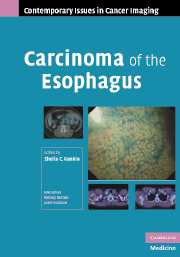Book contents
- Frontmatter
- Contents
- Contributors
- Series foreword
- Preface to Carcinoma of the Esophagus
- 1 Epidemiology and Clinical Presentation in Esophageal Cancer
- 2 Pathology of Esophageal Cancer
- 3 Recent Advances in the Endoscopic Diagnosis of Esophageal Cancer
- 4 Endoscopic Ultrasound in Esophageal Cancer
- 5 CT in Esophageal Cancer
- 6 FDG-PET and PET/CT in Esophageal Cancer
- 7 The Role of Surgery in the Management of Esophageal Cancer and Palliation of Inoperable Disease
- 8 Chemotherapy and Radiotherapy in Esophageal Cancer
- 9 Role of Stents in the Management of Esophageal Cancer
- 10 Lasers in Esophageal Cancer
- Index
- References
4 - Endoscopic Ultrasound in Esophageal Cancer
Published online by Cambridge University Press: 08 August 2009
- Frontmatter
- Contents
- Contributors
- Series foreword
- Preface to Carcinoma of the Esophagus
- 1 Epidemiology and Clinical Presentation in Esophageal Cancer
- 2 Pathology of Esophageal Cancer
- 3 Recent Advances in the Endoscopic Diagnosis of Esophageal Cancer
- 4 Endoscopic Ultrasound in Esophageal Cancer
- 5 CT in Esophageal Cancer
- 6 FDG-PET and PET/CT in Esophageal Cancer
- 7 The Role of Surgery in the Management of Esophageal Cancer and Palliation of Inoperable Disease
- 8 Chemotherapy and Radiotherapy in Esophageal Cancer
- 9 Role of Stents in the Management of Esophageal Cancer
- 10 Lasers in Esophageal Cancer
- Index
- References
Summary
Introduction
The major role for endoscopic ultrasound (EUS) is in defining stage of disease. Tumors are staged using the TNM classification, which describes the anatomic extent of cancer at the time of diagnosis and before therapy (Table 4.1). This allows a classification of the stages of cancer for estimation of prognosis and comparing the results of different treatments (Table 4.2). The definitions of TNM are based on the depth of invasion of the tumor into the esophageal wall or beyond (T stage), the presence or absence of regional lymph node involvement (N stage), and identification of distant metastasis (M stage). EUS provides uniquely detailed images of the different layers of the esophagus and surrounding structures. Using standard EUS (5–12 MHz), the esophageal wall is visualized as five layers that correspond to the mucosa (layers 1 and 2), submucosa (layer 3), muscularis propria (layer 4), and the outer, adventitial layer (layer 5) (Figure 4.1).
T staging
Tis is the earliest stage, defined as tumor present in the epithelium but not invading the lamina propria. T1 tumors involve the lamina propria and the submucosa. These can be further subclassified as T1 m where the tumor is confined to the mucosa and T1sm where the tumor invades the submucosa (Figure 4.2). Tumors that invade the muscularis propria are classified as T2 (Figure 4.4), while tumors involving the adventitia are termed T3 (Figure 4.4). Involvement of mediastinal structures such as the pleura, azygous vein, aorta, or adjacent structures indicates T4 disease (Figure 4.5).
- Type
- Chapter
- Information
- Carcinoma of the Esophagus , pp. 44 - 61Publisher: Cambridge University PressPrint publication year: 2007

